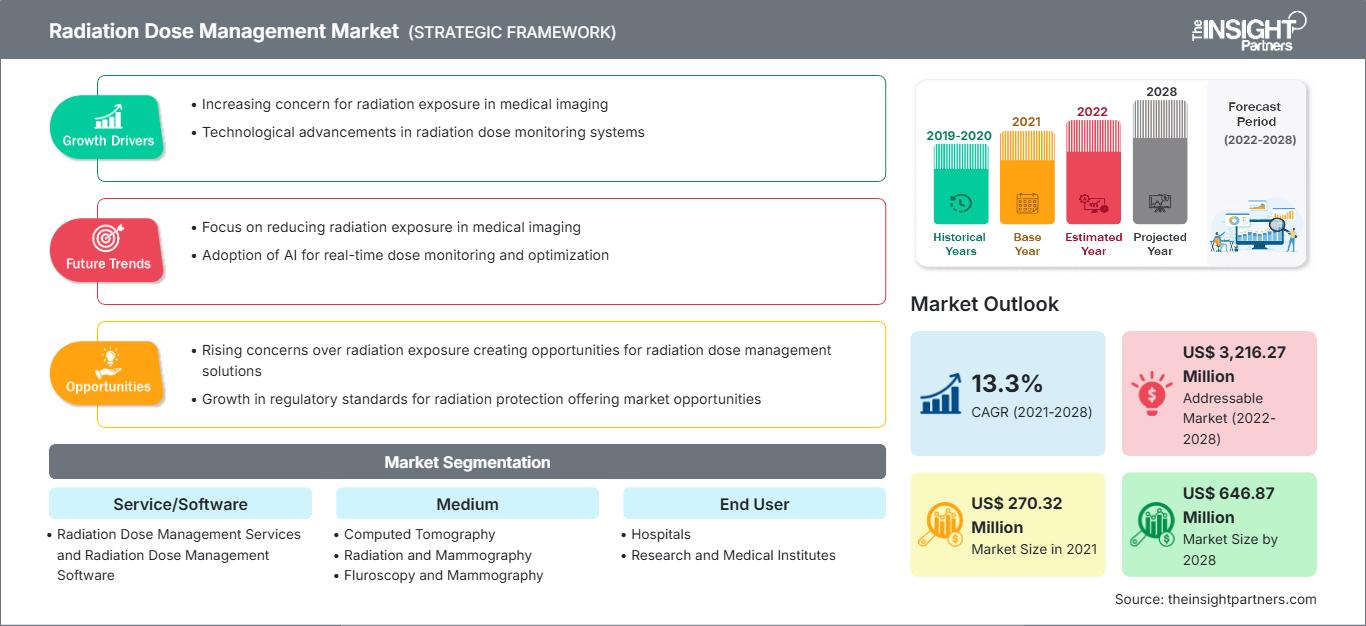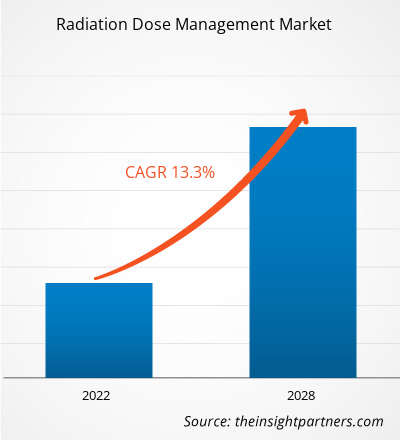Der Markt für Strahlendosismanagement soll von 270,32 Millionen US-Dollar im Jahr 2021 auf 646,87 Millionen US-Dollar im Jahr 2028 anwachsen; für den Zeitraum 2021–2028 wird ein CAGR-Wachstum von 13,3 % erwartet.
Die Strahlentherapie ist ein wichtiger Zweig der Medizin. Verschiedene Krankheiten wie Krebs und Herz-Kreislauf-Erkrankungen werden mithilfe elektromagnetischer Wellen diagnostiziert und behandelt. Sie wird häufig zur Behandlung verschiedener Krebsarten eingesetzt. Allerdings hat die Strahlentherapie auch Nebenwirkungen. Daher ist die Überwachung der richtigen Strahlendosis bei jedem strahlenbasierten medizinischen Verfahren äußerst wichtig. Die Strahlendosis ist die Menge der Strahlung, der der Patient ausgesetzt ist. Das Strahlendosismanagement umfasst Informationen zu Software zur Aufzeichnung der Strahlendosis, zur Echtzeitüberwachung der Dosis durch das Personal, zur Einhaltung gesetzlicher Vorschriften und zu Technologien zur Dosisreduzierung, wie z. B. interaktive Rekonstruktionssoftware.
Das Wachstum des Marktes für Strahlendosismanagement ist auf die wachsende Besorgnis hinsichtlich der Strahlenbelastung und die steigende Zahl von Krebserkrankungen zurückzuführen, die eine Strahlentherapie erfordern. Allerdings behindern die organisatorischen Herausforderungen und das Fehlen von Benchmarking zur Dosisoptimierung das Marktwachstum.
Passen Sie diesen Bericht Ihren Anforderungen an
Sie erhalten kostenlos Anpassungen an jedem Bericht, einschließlich Teilen dieses Berichts oder einer Analyse auf Länderebene, eines Excel-Datenpakets sowie tolle Angebote und Rabatte für Start-ups und Universitäten.
Markt für Strahlendosismanagement: Strategische Einblicke

-
Holen Sie sich die wichtigsten Markttrends aus diesem Bericht.Dieses KOSTENLOSE Beispiel umfasst Datenanalysen, die von Markttrends bis hin zu Schätzungen und Prognosen reichen.
Markteinblicke
Wachsender Fokus auf interventionelle Radiologie und Nuklearmedizin
Rasche Fortschritte in der Medizintechnik, der Geräteherstellung und der Bildgebungsausrüstung haben zu einer Verfeinerung ursprünglicher Verfahren durch bessere Techniken und einer Erweiterung der Indikationen für Verfahren geführt. Neue Techniken wurden entwickelt und einige Techniken wurden auf andere Bildgebungsmodalitäten migriert. Aufgrund der hohen Bildgebungseffizienz werden weltweit mehr interventionelle radiologische und nuklearmedizinische Verfahren durchgeführt. Laut der Society of Nuclear Medicine werden in den USA jährlich etwa 20 Millionen nuklearmedizinische Verfahren durchgeführt. Wie die World Nuclear Association berichtet, verwenden weltweit über 10.000 Krankenhäuser Radioisotope in der Medizin und 90 % der Radioisotopenverfahren sind diagnostisch. Marktteilnehmer wie Bayer Healthcare und Sectra Medical Systems bieten Dosismanagementsoftware speziell für RDM in der interventionellen Bildgebung und Nuklearmedizin an. Daher bietet der zunehmende Fokus auf interventionelle Radiologie und Nuklearmedizin Chancen für das Marktwachstum.
Service-/Softwarebasierte Einblicke
Basierend auf Service/Software wurde der globale Markt für Strahlendosismanagement in Strahlendosismanagement-Services und Strahlendosismanagement-Software segmentiert. Das Segment Strahlendosismanagement-Software hatte 2021 den größten Marktanteil und wird im Prognosezeitraum voraussichtlich eine durchschnittliche jährliche Wachstumsrate von 13,6 % verzeichnen.
Mediumbasierte Einblicke
Basierend auf dem Medium ist der globale Markt für Strahlendosismanagement in Computertomographie, Bestrahlung und Mammographie, Durchleuchtung und Mammographie sowie sonstige Medien segmentiert. Das Segment Computertomographie hatte 2021 den größten Marktanteil und wird im Prognosezeitraum voraussichtlich eine durchschnittliche jährliche Wachstumsrate von 13,8 % verzeichnen.
Strahlendosismanagement
Regionale Einblicke in den Markt für StrahlendosismanagementDie Analysten von The Insight Partners haben die regionalen Trends und Faktoren, die den Markt für Strahlendosismanagement im Prognosezeitraum beeinflussen, ausführlich erläutert. In diesem Abschnitt werden auch die Marktsegmente und die geografische Lage in Nordamerika, Europa, dem asiatisch-pazifischen Raum, dem Nahen Osten und Afrika sowie Süd- und Mittelamerika erörtert.
Umfang des Marktberichts zum Strahlendosismanagement
| Berichtsattribut | Einzelheiten |
|---|---|
| Marktgröße in 2021 | US$ 270.32 Million |
| Marktgröße nach 2028 | US$ 646.87 Million |
| Globale CAGR (2021 - 2028) | 13.3% |
| Historische Daten | 2019-2020 |
| Prognosezeitraum | 2022-2028 |
| Abgedeckte Segmente |
By Service/Software
|
| Abgedeckte Regionen und Länder |
Nordamerika
|
| Marktführer und wichtige Unternehmensprofile |
|
Dichte der Marktteilnehmer im Bereich Strahlendosismanagement: Verständnis ihrer Auswirkungen auf die Geschäftsdynamik
Der Markt für Strahlendosismanagement wächst rasant. Die steigende Nachfrage der Endverbraucher ist auf Faktoren wie veränderte Verbraucherpräferenzen, technologische Fortschritte und ein stärkeres Bewusstsein für die Produktvorteile zurückzuführen. Mit der steigenden Nachfrage erweitern Unternehmen ihr Angebot, entwickeln Innovationen, um den Bedürfnissen der Verbraucher gerecht zu werden, und nutzen neue Trends, was das Marktwachstum weiter ankurbelt.

- Holen Sie sich die Markt für Strahlendosismanagement Übersicht der wichtigsten Akteure
Endbenutzerbasierte Erkenntnisse
Basierend auf dem Endbenutzer ist der Markt für Strahlendosismanagement in Krankenhäuser, Forschungs- und medizinische Institute und andere segmentiert. Das Krankenhaussegment hatte 2021 den größten Marktanteil und wird im Prognosezeitraum voraussichtlich die höchste durchschnittliche jährliche Wachstumsrate (CAGR) von 13,6 % verzeichnen.
Produkteinführungen und -zulassungen sind häufig angewandte Strategien von Unternehmen, um ihre globale Präsenz und ihr Produktportfolio zu erweitern. Darüber hinaus konzentrieren sich die Akteure auf dem Markt für Strahlendosismanagement auf die Partnerschaftsstrategie, um ihren Kundenstamm zu erweitern, was ihnen wiederum ermöglicht, ihren Markennamen weltweit zu behaupten.
Firmenprofile
- FUJIFILM Holdings Corporation
- Bayer AG
- Bracco Imaging SpA
- GE Healthcare
- Koninklijke Philips NV
- Medsquare
- Novarad Corporation
- QAELUM INC
- Sectra AB
- PACSHealth, LLC
- Historische Analyse (2 Jahre), Basisjahr, Prognose (7 Jahre) mit CAGR
- PEST- und SWOT-Analyse
- Marktgröße Wert/Volumen – Global, Regional, Land
- Branchen- und Wettbewerbslandschaft
- Excel-Datensatz
Aktuelle Berichte
Verwandte Berichte
Erfahrungsberichte
Grund zum Kauf
- Fundierte Entscheidungsfindung
- Marktdynamik verstehen
- Wettbewerbsanalyse
- Kundeneinblicke
- Marktprognosen
- Risikominimierung
- Strategische Planung
- Investitionsbegründung
- Identifizierung neuer Märkte
- Verbesserung von Marketingstrategien
- Steigerung der Betriebseffizienz
- Anpassung an regulatorische Trends






















 Kostenlose Probe anfordern für - Markt für Strahlendosismanagement
Kostenlose Probe anfordern für - Markt für Strahlendosismanagement